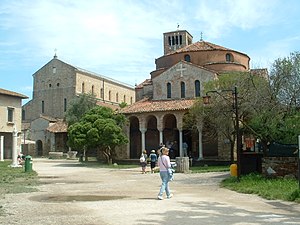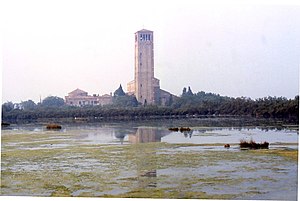‘Torcello’ means ‘tower and sky’ but I thought it sounded like something you could eat or drink that was both sweet and delicious, possibly alcoholic. Bearing this in mind, and as it’s only a short hop on the vaporetto (water bus) from Burano, it would have been just plain rude not to visit.
Everybody streamed off the vaporetto in the same direction, as though they all knew, by some means of collective consciousness, which direction to go. We all trotted for the best part of a kilometre, under the searing sun, down a pathway, paved, pink and pretty, which ran alongside a still, green canal.
An unexpected busker was playing the accordion, temporarily drowning out the cicadas screeching in the parched bushes. I tossed a euro coin into the cap slung on the ground in front of him and he nodded, ‘Grazie.’
The ponte del diavolo – devil’s bridge – looked new and scrubbed, no sign of beelzebub though so to make up for the disappointment, I imagined a troop of horned, villainous, little devils in red sequinned suits dancing across it.
Finally we all came to a cloistered church and a cathedral. I’m rarely moved by churches or cathedrals. Some of them are incredible feats of architecture that have stood for hundreds of years and that’s quite amazing isn’t it? But I’m far more fascinated by seeing how people live, watching their behaviour and soaking up the general feel of a place and imagining how it used to be.
Anyway here were the Cathedral of Santa Maria Asunta and the Church of Santa Fosca. I didn’t care. My brains were bubbling in the heat and I just wanted to crawl on my belly into the shade and whimper like a dog.
In the shade of the cloisters a young Goth couple, perched on a wall, were demonstrating that the flush of a young romance cannot always bear the heat and stress of a holiday together. It was so tempting to eavesdrop their unhappy griping but instead, I did the noble thing and left them to it.
At a cold drinks stall a smiling lady charged me 3.50 euros for a bottle of Coke. I suppose if I were the only person selling cold drinks in 50 million degree heat, I too might smile with delight, charging outrageous amounts of money to feverish visitors.
Glugging on the Coke and fantasising about cold showers, I wandered over to look through a gate. There, peering back through the bars, in a little walled courtyard, was a group of child-like statues with cheeky faces.
‘Hello,’ the nearest girl seemed to say, ‘it’d be nice to come out and play.’ I wanted to take them home with me.
A friend, looking at the photo on my return, remarked, ‘An orphanage for statues.’
Despite the obvious love and adoration of my new adopted family, the sensation that my brain was melting had not abated so I set off back along the interminable path to the vaporetto stop and tried, unsuccessfully, to fold my crumpled newspaper into a hat, startling the accordion busker who’d sprung into tune. He stopped abruptly and slumped against the fence as soon as I’d scuffled past.
‘Don’t you remember, I gave you a euro?’ I muttered. The newspaper fluttered off my head, carried away on a gust of wind and I lifted my face, hoping the little group of statue friends could feel it too.
Anyway that’s enough of that sentimental nonsense. Let’s have a bit of history.
In the early 600s, a whole bunch of folks fled to Torcello Island from the town of Altino on mainland Italy, having decided that a mosquito-riddled lump in the middle of a swamp wouldn’t ruin their day quite as much as facing the marauding hoards from Northern Europe.
They found ways to build homes on the marshy land; constructed canals, bridges and forts, and by the 10th century the little city of 20 000 people, glittering with churches and palazzi, was more beautiful and more powerful than neighbouring Venice.
Torcello’s harbour became a prosperous trading spot with the enterprising islanders trading wool plus salt and fish from the surrounding lagoons. As a society, they even organised themselves along democratic lines.
By the 1300s, sandbanks emerged in the surrounding salt lagoon and it became too marshy to navigate. Now it was the mosquitoes’ turn to thrive and malaria wiped out much of the population. The island came under attack again causing the Doge* to move to the mainland where it was safer and by now, grander. The remaining inhabitants drifted off to mainland Venice, Burano and Murano. The island became swamped by wild vegetation, the canals silted up and the grand palazzi, houses and churches crumbled away and were taken away by Venetians to use as building materials.
Now, the population barely numbers two dozen.
Trip Advisor hosts a slew of indignant reviews about Torcello : ‘Very disappointed! There’s nothing there,’ they cry in a variety of languages. Well, yes, this is almost true and I am as guilty as everyone else for dismissing Torcello while (mostly because the heat was sending me doolally) but it has an inspiring and exciting story behind it and apparently, some of the most beautiful frescoes in Italy.
Do visit but read about it first.
Take water. Take a hat.
* Doge – elected Chief of State.






